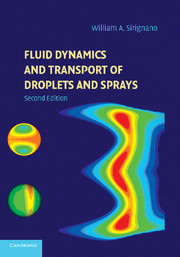Book contents
- Frontmatter
- Contents
- Preface
- Nomenclature
- 1 Introduction
- 2 Isolated Spherically Symmetric Droplet Vaporization and Heating
- 3 Convective Droplet Vaporization, Heating, and Acceleration
- 4 Multicomponent-Liquid Droplets
- 5 Droplet Behavior under Near-Critical, Transcritical, and Supercritical Conditions
- 6 Droplet Arrays and Groups
- 7 Spray Equations
- 8 Computational Issues
- 9 Spray Applications
- 10 Spray Interactions with Turbulence and Vortical Structures
- 11 Film Vaporization
- 12 Stability of Liquid Streams
- Appendix A The Field Equations
- Appendix B Conserved Scalars
- Appendix C Droplet-Model Summary
- Bibliography
- Index
2 - Isolated Spherically Symmetric Droplet Vaporization and Heating
Published online by Cambridge University Press: 05 June 2012
- Frontmatter
- Contents
- Preface
- Nomenclature
- 1 Introduction
- 2 Isolated Spherically Symmetric Droplet Vaporization and Heating
- 3 Convective Droplet Vaporization, Heating, and Acceleration
- 4 Multicomponent-Liquid Droplets
- 5 Droplet Behavior under Near-Critical, Transcritical, and Supercritical Conditions
- 6 Droplet Arrays and Groups
- 7 Spray Equations
- 8 Computational Issues
- 9 Spray Applications
- 10 Spray Interactions with Turbulence and Vortical Structures
- 11 Film Vaporization
- 12 Stability of Liquid Streams
- Appendix A The Field Equations
- Appendix B Conserved Scalars
- Appendix C Droplet-Model Summary
- Bibliography
- Index
Summary
There is interest in the droplet-vaporization problem from two different aspects. First, we wish to understand the fluid-dynamic and -transport phenomena associated with the transient heating and vaporization of a droplet. Second, but just as important, we must develop models for droplet heating, vaporization, and acceleration that are sufficiently accurate and simple to use in a spray analysis involving so many droplets that each droplet's behavior cannot be distinguished; rather, an average behavior of droplets in a vicinity is described. We can meet the first goal by examining both approximate analyses and finite-difference analyses of the governing Navier–Stokes equations. The second goal can be addressed at this time with only approximate analyses because the Navier–Stokes resolution for the detailed flow field around each droplet is too costly in a practical spray problem. However, correlations from Navier–Stokes solutions provide useful inputs into approximate analyses. The models discussed herein apply to droplet vaporization, heating, and acceleration and to droplet condensation, cooling, and deceleration for a droplet isolated from other droplets. The governing partial differential equations reflecting the conservation laws are presented in Appendix A. Several coordinate systems are considered. Formulations with primitive velocity variables and formulations with stream functions are discussed. Appendix B discusses some conserved scalar variables whose analytical use can be very convenient and powerful under certain ideal conditions.
Introductory descriptions of vaporizing droplet behavior can be found in the works of Chigier (1981), Clift et al. (1978), Glassman (1987), Kanury (1975), Kuo (1986), Lefebvre (1989), and Williams (1985).
- Type
- Chapter
- Information
- Fluid Dynamics and Transport of Droplets and Sprays , pp. 8 - 29Publisher: Cambridge University PressPrint publication year: 2010
- 1
- Cited by



